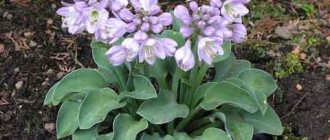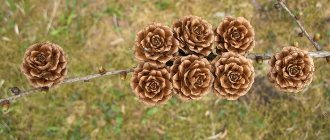Author: Natalya Category: Houseplants Published: January 19, 2021Republished: January 19, 2021Last edits: January 19, 2021
- Diseases
Lithops - “living stones”, as they are often called - belong to the genus of succulents of the Aizaceae family, which includes more than three dozen species growing on the sandy and rocky soil of hot African countries - Namibia, Botswana and South Africa. The shape of lithops really resembles sea pebbles with a height and width of 2.5-5 cm. From August to November, white, yellow, and less often orange flowers up to 5 cm in diameter open on them.
The annual cycle of lithops is of interest: in the summer, when the weather is dry and the days are long, they are at rest. These plants grow and flower during the autumn rainy season. In winter, when the day shortens, lithops dormant, but it is then that they form a new pair of leaves, and sometimes even two. Old leaves nourish and protect new growth, gradually become depleted and eventually burst. In spring, during the rainy season, before dryness and heat sets in, young leaves accumulate water.
These African succulents also react to temperature, humidity and day length in indoor culture, so it is important to know where Lithops grows in nature and what microclimate it needs.
general information
To date, botanists have identified and studied more than a hundred species of lithops - “living stones”, which are representatives of the Aizaceae family.
This is interesting! These stone plants were first discovered by the English naturalist William John Burchell, traveling through South Africa in the early 19th century. Once he realized that the pebble in front of him was actually a plant, the naturalist made detailed sketches in which he depicted Lithops turbinoformis.
Cacti are so good at camouflage that their discovery was an accident. Subsequently, they were studied and the secret of their amazing mimicry was unraveled - lithops evolved over time, protecting themselves from natural ill-wishers - herbivorous living creatures. They not only “pretend” to be pebbles, but are also able to completely replicate the color of the landscape around them.
The plant was named “Lithops” (Greek for “stone”) in 1922; experts focused on their appearance; they really look very much like a scattering of colored pebbles. Like other succulents, they are filled with moisture, valuable in desert and arid areas, retain it and use it for life and development in harsh climatic conditions.
This is interesting! Lithops have another amazing property: during long droughts, they can completely hide in the soil to extract particles of life-giving moisture.
Most often, “living stones” have very modest dimensions, their diameter does not exceed 5 cm. They have a very short, almost invisible stem to which the foliage is attached. Lithops cacti feed using a long taproot system.
Why did this plant attract the attention of flower growers, besides its original appearance? First of all, because it does not require labor-intensive care at home, caring for lithops is no more difficult than other succulent plants. There are also many types of these flowers and you can regularly replenish the collection, and in addition, in the fall they delight with very spectacular flowering.
Species diversity
Many succulent lovers admit that once they get at least one type of “living stone”, it is impossible to stop, which is quite understandable - the variety is truly impressive.
Optics
Lithops of this species has an unusual lilac-lilac color, the inner surface of the leaves is lighter than other areas. The flower buds have long white petals with rounded edges and pale yellow stamens. The buds are located deep “in the cracks” between the leaves. The height of adult optics does not exceed 2 cm.
Optics
Olive green
The leaves of this “living pebble” have the shape of a heart, with halves with a truncated upper part. The color of the flower is gray with a greenish tint, the flat top is intense gray with whitish inclusions. The peduncle of the olive-green lithops is light green, the flower buds are a delicate yellow shade.
Olive green
Marble
The tops of the leaves are grayish-whitish or greenish-gray with broken lines of a deep gray shade that form a “marbled” pattern. Lithops marble has a velvety surface, the flowers have snow-white petals and yellow centers, a diameter of about 50 mm.
Marble
Leslie
Lithops of this species have significantly shortened, reverse-cone-shaped, fleshy leaves. The color is gray or blue-gray. The “cracks” between the foliage are shallow, in most cases in the shape of an arc.
On the surface of the truncated foliage, the pattern resembles a mesh, which diverges from several thick “trunks” or a darkish spot that occupies the lion’s share of the top.
Leslie
Brownish
This is a brownish-brown or coffee-brown flower, the flattened surface of its foliage is covered with spots of various shapes. In the intervals between them, the color is more intense, so it seems that the leaves are covered with a dark mesh.
The flowers are a bright yellow lemon shade with a column of a large number of the same yellow stamens. The flowers often reach 3 cm in diameter.
Brownish
Aucamp
These lithops or living stones are quite popular among gardeners; they differ from other representatives of the species in their densely fused foliage. The cracks dividing the flower into 2 parts are small and short. At the tops of the leaves there is a pattern consisting of various spots and thick lines. The cracks have the same color as the lower part, the outer edge is bordered.
Aucamp
Pin-shaped
Due to the brick-coffee hue and the usual shape for lithops, the leaves of the plant resemble lightly roasted coffee beans. On the truncated tops there is a dark brown pattern of mesh and spots.
The blossoming buds of the pin-shaped lithops are yellow-orange; the succulent blooms all summer and autumn.
Pin-shaped
Beautiful
The foliage of the succulent is gray-olive or ocher-olive in color; between the leaves there is a break that reaches almost to the soil. The surface of the sheets is dotted with a dark olive pattern consisting of broken lines.
Adult flowers rise 3 cm above the ground and quickly become overgrown with baby flowers. The beautiful Lithops buds form and open in September, the flowers have white petals and a pleasant, pronounced scent.
Beautiful
Divided
A succulent with greenish-gray foliage, on the plates there is a pattern consisting of specks of a rich shade. And if the foliage of most living stones has a truncated heart-shaped shape or looks like coffee beans, then the foliage of the divided one is in the form of a forked cylinder or hoof. Lithops flowers of this species are yellow.
Divided
Soleros
This plant looks like a slingshot stuck into the ground, the foliage is cylindrical in shape, olive green in color. The main color of the upper part of the leaves is dark greenish, the middle is dark gray, bordered by a light shade. During flowering, one white flower appears, similar to garden asters.
Soleros
False truncated
It differs from most lithops in the small and narrow break between the two leaves. Various colors: brown, pink, gray. The height of adult bushes is no more than 3 cm.
The flat horizontal part of the sheets is covered with a pattern of the same color as the main color, but in a more saturated tone. False truncated lithops blooms in September-October with golden-yellow flowers.
False truncated
Typically, gardeners who are keen on growing “living stones” do not stop at just one variety. Moreover, different stones can be planted in one container and the lithops mix looks very impressive, especially when the succulents begin to bloom profusely.
Common varieties
The varieties of living stones listed in the table are most often grown indoors.
| Variety | Description and features |
| Lithops bella, i.e. Beautiful | It is distinguished by beautiful brownish leaves and has several pairs of leaves. Diameter about 2 cm, height - up to 3 cm. The flowers exude a very delicate aroma. Flowers are white. |
| Lithops divergens, or Divided | It has green leaves with gray spots. The size of a pair of leaves can range from 1 to 3 cm, with a beveled surface. Flowers are yellow. |
| Lithops salicola, or Soleros | The leaves are gray, height from 2 to 2.5 cm. The diameter of the plant is also about 2.5 cm. Dark spots stand out brightly on the olive-colored surface. Flowers are white. |
Advantages of growing lithops yourself
Modern floriculture is quite developed and today many specialized stores offer a wide range of homemade plants from different parts of the planet. But, as for lithops, most often gardeners prefer to grow them at home, using seeds, without buying adult succulents, and there are a number of objective reasons for this:
- if you try, you can find “live stones” on sale, however, most likely, they will be represented by 2-3 types and collecting a large collection will be a difficult task;
- the price of these amazing succulents is quite high, which experienced plant growers consider unjustified - even beginners can grow lithops from seeds and these flowers are very unpretentious;
- often imported succulents are kept in unsuitable conditions - they are planted in universal soil, which is too nutritious for them and watered along with other green inhabitants; this leads to the fact that acquired pets are infected with rot, have a deformed root system and die almost immediately;
- All plant growers are unanimous - plants grown from seeds bloom better, have increased endurance and can more easily withstand unfavorable conditions.
Therefore, in order to become the owner of a diverse collection of “living stones,” it is recommended to either take plants from the natural environment, or find out how you can grow lithops at home from seeds. As a rule, all the efforts made pay off handsomely - succulents germinate well, grow quickly and soon begin to delight the owner with beautiful flowering.
When to plant: the right time of year for propagation
Experienced gardeners advise breeding lithops from early spring to late summer, as they are very light-loving. But you can start growing exotic plants in the cold season, only in this case it will be necessary to provide the flowers with additional lighting.
Despite the fact that lithops love light, it has been noted that seeds germinate best when there are significant fluctuations in air temperature. Therefore, if there is additional lighting, then you can start breeding them in the off-season.
Purchase of seed material
Lithops seeds have a high germination rate and if the storage conditions are met, they retain this quality for decades. This property is due to the special structure of the seeds - the fruits of the succulent are contained in a chamber made of dense material, which perfectly protects them from external aggressive influences and is destroyed when they fall on favorable soil.
It is advisable to purchase seeds directly from the manufacturer or using the services of a trusted supplier. As a rule, sellers who value their reputation and customers distribute only high-quality products that retain their properties and take care of high-quality storage and transportation of seeds.
Seedling care
After the seedlings appear, the container is left under glass for several more weeks.
Young lithops are gradually accustomed to the dry air of an apartment by ventilating the container three times a day for 20 minutes.
It is now necessary to water the seedlings only when the surface of the soil in the container dries out. If the seedlings are located in direct sun, they need to be shaded.
After 3-4 weeks the container is opened. Water small lithops very carefully so that as little water as possible gets on their surface.
It should be remembered that excessive watering can destroy the entire crop of lithops.
Pot and soil for planting seeds
When choosing a pot for lithops, it is worth considering that they are succulent plants - slow-growing, with a superficial, not very developed root system, which does not quickly colonize the earthen ball. Therefore, it is best to take a small, spacious container for planting living stones, which must have drainage holes.
The tank is filled with a special soil mixture, which you can prepare yourself by mixing the following components:
- crumbs from ordinary red bricks - 1 part;
- turf substrate - 2 parts;
- clay – 1 part;
- sand – 2 parts;
- peat soil - 1 part.
But you can also buy soil for lithops in the store; mixtures for succulent plants and cacti are suitable for them. It is recommended to add drainage material to it, thanks to which the soil becomes looser, its air conductivity increases and the removal of excess moisture improves.
These plants are accustomed to poor sandy soils, so they should be provided with similar soil at home. Before planting lithops seeds, it is recommended to steam or calcinate the soil mixture in the oven, cool and loosen.
The container is filled a quarter with drainage - fine gravel, perlite, expanded clay or brick chips. Then soil is poured in and moistened.
Planting algorithm and process features
Growing a garden from living pebbles is not difficult, and even beginners in floriculture can immediately plant lithops seeds of various types. This is a very interesting experience that will allow you to get different varieties of succulents at once.
You can plan planting at any time of the year, however, sowing in the summer and spring is the most effective. Before sowing, lithops seeds should be placed in a weak solution of potassium permanganate (potassium permanganate) for 4–6 hours. After the procedure, they do not need to be dried, but immediately added to moist soil.
The seeds are laid out on the surface and sprinkled with a thin layer of sand. They should not be deepened or covered with soil. If the tank is equipped with a lid, it must be closed or glass or cling film used for this purpose.
Since the material of living stones remains viable for a long period, it can be expected that sprouts will appear from all seeds. They will most likely germinate unevenly and the first shoots will appear in the first week.
And in order to get stable, friendly shoots, you need to find out in advance how to grow lithops from seeds and what features of their germination at home should be remembered. It is advisable to bring the regime as close to natural as possible:
- the soil temperature in the container (greenhouse) during the day is on average +30 degrees, at night – no more than +18 degrees;
- if the soil begins to dry out, do not water it, but spray it using a spray bottle;
- When growing lithops from seeds, the planting must be ventilated daily by opening the lid and removing the glass or plastic partition for 10 minutes.
If you provide lithops seeds with proper care and bring home conditions closer to natural ones, the first sprouts will hatch in approximately 4–5 days. The average duration of their germination is 1.5-2 weeks.
During this period, care for lithops should include the following points:
- After the emergence of seedlings, they should be ventilated more often - 3-4 times a day for a quarter of an hour.
- It is important that the air temperature in the tank with the seedlings is no higher than +40 degrees; the container should not be placed where it is exposed to direct sunlight.
- However, young succulents, like adults, require a lot of light, so it is better to place them closer to its natural source. If this is not possible, then it is recommended to provide the flowers with artificial lighting. But, halogen lamps are not used for these purposes.
- When the seedlings grow and turn into peas, the soil needs to be mulched with small stones.
- If the soil is waterlogged, covered with moss or mold, it should be treated with a slightly pink solution of potassium permanganate.
- We must not forget about accustoming young lithops plants to air, so the tank should be ventilated daily.
- The planting should be watered using a tray - water is poured into it and removed after a certain period.
- Like other succulent plants, living pebbles grow very slowly, and the same applies to the root system. So, if they start to fall over without being held by their roots, you need to help them using a toothpick. The plant should be placed vertically and slightly pressed into the soil.
When the sprouts get a little stronger, the amount of watering is reduced, and irrigation is no longer required. After 2 months, the “pebbles” will begin to look like adult succulents and it will be possible to transplant the lithops to a permanent “place of residence.”
The slow growth of these flowers can be called a big advantage, especially when it comes to small compositions. They will retain their original attractive appearance for many years. And succulents will delight the owner with their first flowering already 3 years after sowing.
This is interesting! In Feng Shui, these small flower-pebbles are valued very highly. They are considered a powerful source of positive energy, which people are able to feel when they are in the same room with lithops.
Do small plants need to be replanted? Do they need replanting?
Small lithops do not need replanting. But picking may be required if the crops have been thickened. Only such a situation can serve as a reason for a transplant.
To avoid such a tedious procedure, it is better to sow seeds less frequently.
Transplanting lithops and caring for them as adult plants is possible only after two years of age. In this case, you should use deep pots; the composition of the soil can be the same as that used for small plants, with the obligatory addition of sand.











